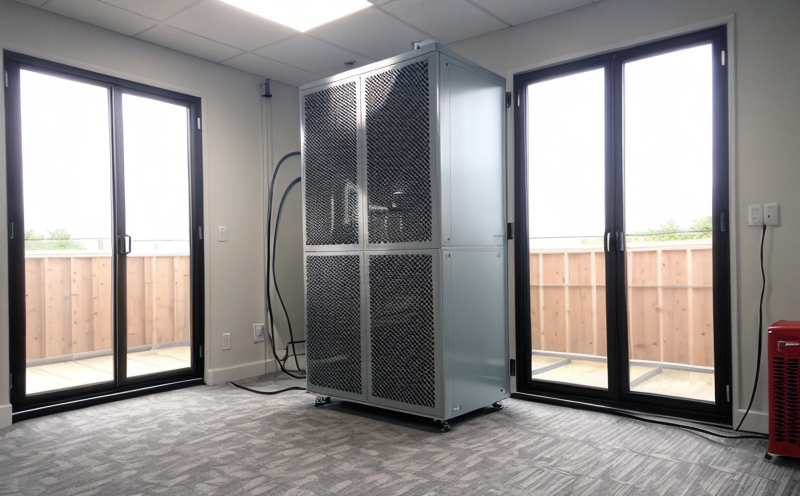ISO 14644-5 Contaminant Removal Efficiency and Flow
The ISO 14644 series of standards is widely recognized in industries that require controlled environments, such as pharmaceuticals, electronics manufacturing, aerospace, and healthcare. Specifically, ISO 14644-5:2019 focuses on the testing methods for contaminant removal efficiency and flow rate in air conditioning and ventilation systems within cleanroom facilities.
This standard is crucial for ensuring that HVAC equipment maintains optimal performance in keeping contaminants at acceptable levels, thereby safeguarding product quality and worker safety. The test protocol involves measuring the particle reduction efficiency of an air filtration system under various conditions including airflow rates and different types of particles (e.g., 0.3 microns). This comprehensive approach allows facilities to assess their HVAC systems' ability to meet stringent cleanroom classification requirements outlined in ISO standards.
The testing process begins with thorough preparation of the specimen, which typically includes placing the filter element into a test chamber that simulates real-world operational conditions. Air is circulated through this setup at specified flow rates while particles are introduced into the incoming airstream according to predefined protocols. As the air passes through the filter, any captured contaminants must be accurately measured before and after filtration.
Once testing is complete, detailed reports are generated summarizing the results obtained during each measurement phase. These documents provide critical insights regarding both particulate removal performance and overall airflow characteristics of the tested equipment. Compliance with ISO 14644-5 not only ensures adherence to international quality standards but also enhances trust among stakeholders by demonstrating a commitment to maintaining high levels of cleanliness within controlled environments.
Our laboratory follows all relevant guidelines set forth in this standard when performing these tests, ensuring accurate and reliable results every time. By leveraging our expertise and state-of-the-art facilities, we can help your organization achieve compliance while optimizing operational efficiency for long-term success.
Industry Applications
- Pharmaceutical Manufacturing: Ensuring that cleanroom environments meet strict particulate matter limits is essential for producing safe medications. ISO 14644-5 helps facilities verify their HVAC systems' ability to maintain these standards.
- Electronics Production: Semiconductors and other electronic components are extremely sensitive to dust and other airborne particles; proper filtration ensures product integrity.
- Aerospace Engineering: Cleanroom environments are vital for the production of intricate parts where even microscopic contaminants could compromise performance. Regular testing maintains air quality standards necessary for reliable manufacturing processes.
- Healthcare Facilities: Hospitals and other medical institutions rely on clean air to prevent contamination from pathogens, ensuring patient safety during surgeries or treatments requiring sterile conditions.
International Acceptance and Recognition
The ISO 14644-5 standard has gained widespread acceptance across numerous industries due to its rigorous testing methods and consistent approach to evaluating HVAC equipment performance. Many countries have adopted this standard as part of their national regulations, further emphasizing its importance within global quality assurance frameworks.
By aligning with these internationally recognized standards, organizations can ensure they are meeting the highest possible standards for air filtration systems used in controlled environments. This not only enhances reputation but also facilitates smoother interactions between international partners by providing common ground for collaboration based on shared compliance expectations.
Competitive Advantage and Market Impact
In today’s competitive marketplace, maintaining high-quality standards is key to standing out from the competition. By adhering to ISO 14644-5 during HVAC equipment testing, your organization demonstrates a strong commitment to excellence in environmental control solutions.
Compliance with this standard can significantly enhance market credibility and customer trust. Consumers increasingly demand products made under stringent quality controls; demonstrating compliance shows that you meet these expectations. Additionally, being able to showcase successful completion of ISO 14644-5 testing provides a clear differentiator from competitors who may not prioritize such rigorous assessments.
The ability to consistently deliver reliable HVAC systems capable of meeting strict particulate matter limits contributes directly to improved operational efficiency and reduced maintenance costs over time. In an era where sustainability is becoming more important than ever, these efficiencies also align with broader corporate goals around reducing resource consumption and environmental impact.





